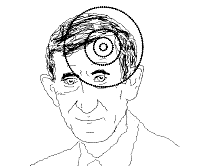 Eric Schwitzgebel had an interesting post the other day asking why the universe isn’t permeated with minds made of complex conjunctions of dust or other stuff. Most people would accept that ‘brains’ can in principle be made out of anything so long as the functional relationships are right; those relationships can be spread out over time and space, and so long as the right relationships are maintained, we don’t even have to keep them in the right order. So shouldn’t there be copies of your mind, and lots of other minds, spread all over the Universe? But that couldn’t be true…
Eric Schwitzgebel had an interesting post the other day asking why the universe isn’t permeated with minds made of complex conjunctions of dust or other stuff. Most people would accept that ‘brains’ can in principle be made out of anything so long as the functional relationships are right; those relationships can be spread out over time and space, and so long as the right relationships are maintained, we don’t even have to keep them in the right order. So shouldn’t there be copies of your mind, and lots of other minds, spread all over the Universe? But that couldn’t be true…
For a more careful exposition and an interesting discussion, see the original post. I think I fall on the sceptical side of this dialogue, more or less for some of the reasons articulated in the comments over there, so I won’t repeat the points already made. Briefly, thought, consciousness, is surely a process, and if you split it up over time and space the process isn’t really there. Never mind cogitation; would we even say that digestion could be instantiated by such a set-up? Here is a set of atoms; they are scattered over a huge area and thousands of years, but taken together in the right order they could constitute a steak and kidney pie; if you don’t like that, perhaps the pie could appear momentarily, or even for several minutes, as the result of a bizarre but providential quantum accident inside my fridge, say. Then here’s another set, or another bizarre occurrence, which duplicates the pie in a state of beginning to be bitten. And so on through to the unmentionable end. That’s not really digestion, is it (and to be honest, perhaps not a totally accurate translation of Eric’s argument either)?
But it’s interesting to take a different tack and bite the bullet instead of the pie. Yes, OK, all that dust does have mental experience. But surely it only has the most tenuous and ethereal kind. To take another ridiculous example, suppose we were talking about an axe. Normally we require all the parts of an axe to be well co-ordinated in space and time, but we could have a dust-axe which was made up of different parts from different places and centuries. If we make the right selection of parts, we can have a series of axe-slices which even constitute its swinging and cutting wood. But it’s not really a very good axe; its existence relies completely on the support of our imagination, even though it consists entirely of unobjectionable physical items. Its existence is thin and dependent; it’s like the hrönir in the Borges story Tlön, Uqbar and Orbis Tertius, objects that exist only because someone thought they did. The experiences of the dust mind are almost as insubstantial as the experiences of fictional characters, or it seems as if it ought to be so.
But somehow I find myself reluctant to say even that much; reluctant to grant the dust even the most evanescent form of experience. Why is that? It’s because I feel a mind is something real, not just an abstraction which can arise as well out of a mistily conceptual object as out of a solid, fleshy brain. Strangely, I worry less about the axe because it’s clear to me that whether something has axehood is a matter of how we use and think of it. Various mis-shapen stones can have a significant degree of axe-worthiness; you can say they are axes if that suits you, and deny it another time. Surely you can’t endow something with a mind and then take it away as your convenience requires?
But at the same time another part of my mind is taking the opposite tack. All this nonsense about pies and axes misses the point completely, because no-one supposes that such things are constituted by high-order functional relations. Minds, on the other hand, seem very likely to be entities of that kind, and so they are uniquely suited to be the abstract result of some reinterpretation of suitable sections of the world. It’s just your hankering for some soul, some magic homunculus, that prevents you from realising this.
Come to that, what’s the point of the dust? Suppose we couldn’t find a suitable candidate for the role of one mote. OK, we say, it doesn’t really matter, let’s just arrange things so that the other parts of our dust mind behave as if this missing one were actually there. We can easily do that. But if we can remove one mote, why not remove them all? Let the functional relationships remain without physical realisation. If you’re worried that imaginary dust has no causal powers, reflect that at this very moment it is having effects in making me describe it; even as I write, and you in some remote place and time read, it is rearranging in its insidious way the contents of both our minds. But if we can do without the physical realisation, space and time become irrelevant; the Universe is full of minds; in fact every point is a point of view, and Leibniz’s Monadology is vindicated.
Once again I have reached that familliar state of complete confusion…

 I see that at Edge they have kept up their annual custom of putting a carefully-chosen question to a group of intellectuals. This year, they asked “What game-changing scientific ideas and developments do you expect to live to see?”. There were many interesting
I see that at Edge they have kept up their annual custom of putting a carefully-chosen question to a group of intellectuals. This year, they asked “What game-changing scientific ideas and developments do you expect to live to see?”. There were many interesting